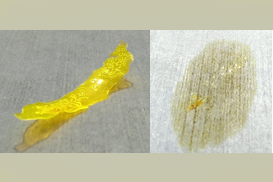Scientists in the US have reported a new polymer that degrades under mild conditions and propagates its own breakdown. Their polyurethanes undergo base-triggered degradation, which releases amines. These amines catalyse the process and result in breakdown across the material.
Every repeating unit of the polymer features a base-sensitive Fmoc-protected carbamate. Hexylamine is one of several bases that trigger the autocatalytic degradation, through proton abstraction, E1cB elimination and decarboxylation.
To visualise the process the team also made a cross-linked polyurethane gel analogue that contained bromothymol blue, a halochromic pH indicator. Adding a trace amount of hexlyamine N-methylpyrrolidone solution to the centre of the gel initiates the spectacular process. The degraded material turns deep blue as terminal amino groups form, which generate the ring open form of the pH indicator. The yellow solid film becomes a blue solution as the degradation process amplifies and radiates out across the entire gel.

This base amplification process could enhance the disposability of industrial polyurethanes or find use in applications that require the rapid production of an amine base.





















No comments yet